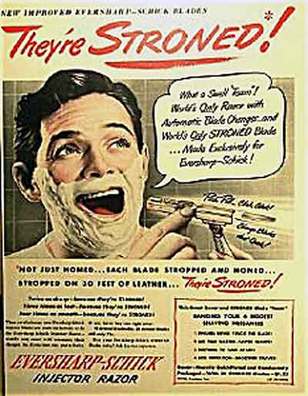Too much innovation: Everybody must get stroned

That’s why I was surprised to hear that he uses a Gillette Mach 3 blade — something you can buy off-the-shelf at the local Duane Reade. As John Allan points out, “Three blades is enough. I tried five blades and didn’t see a real benefit from it.” Let me repeat: three blades is enough.
Which brings me to my innovation question of the day: Is there ever a case when you can have “too much” innovation? I think
that companies like Gillette have been laboring under this delusion,
with their breathless claims of brand-new technology (“Fusion,” “Nitro”) or
breakthrough shaving experiences (e.g. is Mach 3 a razor blade that functions at three
times the speed of sound?). For the past 50 to 60 years, in fact, the razor blade industry has always operated under this assumption — that rapid, technological innovation with razor blades is the way to go. Referencing this 1948 vintage shaving advertisement, Corey Greenberg of the Shave Blog weighs in:
“Shavegeeks tend to romanticize the past, and I’m as guilty of it as
anyone. I talk about safety razors like they’re some pure manifestation
of The Greatest Generation, used by JFK, Cary Grant, and Lee Marvin,
back when men were men and shaved like men, even though the women
probably had legs that felt more like Brokeback Mountain than
smooth ‘n’ silky.
But the more I delve into shaving’s past, the
more I see that the times, they’ve never really a’ changed much. Witness
this 1948 magazine advertisement for the then-new Schick/Eversharp
Injector safety razor, and its absurd claim that each and every blade
was “stroned!”
Stroned?
That
is to say, stropped and honed, like a straight razor’s edge — honed on
a whetstone, and stropped on a hanging leather strop. Serious he-men
wetshavers who use a straight razor have to periodically hone their
razors on a stone, and then before each and every shave, they swipe the
blade to and fro on a leather strop to keep the edge keen. But safety
razor blades?
I believe Schick was honing all of their
Injector blades — all razor blades are “honed” in one way or another,
whether it’s done with a stone or a laser beam. But am I really
supposed to believe Schick was stropping each and every Injector blade
with “30 ft. of leather” any more than I’m supposed to believe that the
Mach3 Power’s “micro-pulses” make the shave closer?
How stroned do they think I am?”
[image: Shave Blog]




